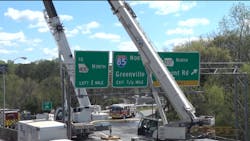With Interstate 85 through Atlanta severed like an artery following the major bridge collapse March 30, Georgia Dept. of Transportation officials have given a rundown of the damage, the repair plan and exactly when they expect vehicles will again be driving on the rebuilt section of I-85.
Even with the I-85 bridge out, it may be that the impact on freight movement through the area will be less than some had feared, points out transportation blogger Ken Harper. One big reason he cites: "most trucks have to take I-285 to go around Atlanta, not through it."
But certainly, for freight that needs to get to Atlanta and merchants and other businesses in the city, this is a huge concern, and passenger car overflows onto alternate routes could swell traffic loads on other roads that trucks rely on. Georgia DOT Commissioner Russell McMurry put it this way: "Our full focus and attention has to be on getting I-85 opened, first and foremost, as quickly as possible."
:: Here's a rundown of the situation and the plans to get this resolved:
What happened?
• McMurry summarized information that's been released about what caused the sustained, intense fire that ultimately led to the collapse of the I-85 bridges above it. The state had stored materials including high-density polyethylene, or HDPE, and fiberglass conduit materials — plastic piping used for things like road wiring, essentially — at the Piedmont Road site where the bridges burned.
• The extra materials had been stored there since about 2011 and were left over from an incomplete 2007 project where the contractor went into default, so the state kept the materials to use perhaps in another project.
• The materials were fenced off with no-trespassing signs. The fire, which is still being investigated, was set deliberately by one or more individuals.
• McMurry says he believes the state was within its policies for materials storage in this case, and notes that this collapse site is an anomaly and was the only such storage location of materials of this kind. He has asked for a statewide review of storage policies in light of this event and has informed DOT officials nationally of this potential situation to "make this a learning opportunity for the nation."
Nuances of the collapsed bridges
• According to GDOT Chief Engineer Meg Pirkle, the collapsed I-85 bridges were built in 1984 and last inspected Aug. 23, 2015, and at that time were deemed in good condition with normal wear for their age and type.
• One complicating factor in this case is that bridge beams used for the collapsed spans of highway are outmoded and different than what's in standard use today. Rather than fabricate those same older beam types — which the state says would've taken much longer — the plan is to rebuild the bridges to a modern standard using current beam designs.
• By the night after the bridges collapsed, engineering teams had transmitted plans for the redesigned beams to fabricators so the beams could begin to be made and that process could get moving. GDOT and other agencies involved are sending across info and specifications on other parts as well that will be needed to get pre-fabrication started ASAP.
• The complete, final I-85 repair plans were transmitted to the contractor by midnight on Sunday, April 2.
'Fewer than 10 weeks'
• Marc Mastronardi, director of construction for GDOT, has laid out hard timelines over which the state expects this repair will take place. The contractor selected is C.W. Matthews, which did repair work in Georgia before in 2001 after a fire on I-285.
• The process by which the state normally would bid and award a contract was streamlined considerably because the bridges' collapse was declared a state of emergency, bringing in federal assistance and certain allowances to hasten things along.
• There will be what may appear to be a "slowdown" of repair work as crews shave down and re-fit/ repair bridge support columns that can be saved, which also is expected to quicken reconstruction, but some columns were too damaged and must be torn down. This is more finessed work that's not as quick as clearing out damaged materials.
• Special 24-hour fast-drying, high-performance — and also more costly — cement will be used to accelerate reconstruction work in this project. This is part of the state's assessment of the need to fix I-85 as quickly as possible, since costs to business due to this situation also mean loss of state revenues, justifying some additional spending to reconnect I-85.
• Mastronardi says to first look for teardown work to conclude soon regarding I-85 debris and the work repairing bridge columns mentioned above. However, things will be fast-tracked going forward: expect bridge beams to begin arriving at the project site by the end of this week, with new bridge beams fully delivered by the end of April.
• "It is our expectation that this bridge will be reopened in fewer than 10 weeks," Mastronardi says, citing a hard "reopened" date of Thursday, June 15, which is exactly 11 weeks after the collapse. The state also plans to incentivize the contractor to finish early, and that bonus amount is tied to the continued cost consideration of I-85 being shut down as it is.
About the Author
Aaron Marsh
Aaron Marsh is a former senior editor of FleetOwner, who wrote for the publication from 2015 to 2019.
